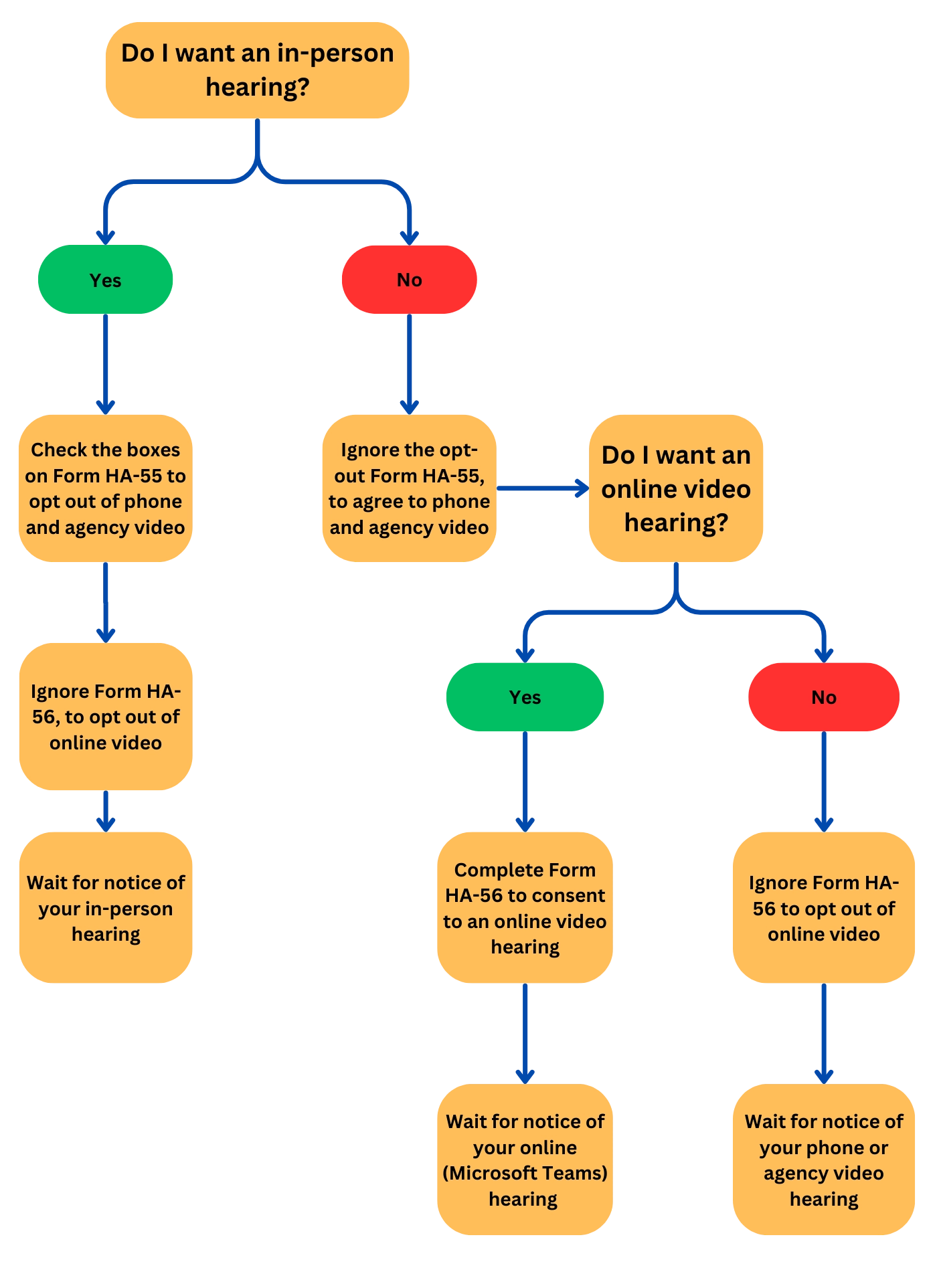Social Security provides several methods for you to conduct your disability hearing. Find out which one is best for you.
If your claim for Social Security benefits has been denied after both initial review and reconsideration, you can appeal further by requesting a hearing with an administrative law judge (ALJ). Because examiners at the earlier stages of the disability determination process don't typically interact much with applicants (outside of reviewing medical records), hearings provide you the best opportunity to make your case directly to the person who will be deciding your disability claim.
Statistically, you're more likely to get a favorable decision on your application after you've had a hearing with an ALJ, which is why most disability attorneys recommend that you appeal a denial rather than starting a new claim over again from square one. Once you've made the decision to request a hearing, you'll need to make another important decision about how you'd like to have your hearing conducted (the "manner of appearance").
How Are Social Security Disability Hearings Conducted?
The Social Security Administration (SSA) currently gives claimants (applicants) four options—one "live," three remote—by which they can appear at their disability hearing.
- In-person hearings require you to be physically present at a Social Security office in the same room as the ALJ.
- Audio hearings are conducted over the telephone from your home or lawyer's office.
- Agency video hearings require you to be physically present at a Social Security office, but the ALJ will be in a different location, using the agency's videoteleconference equipment to appear on a large screen in the hearing room.
- Online video hearings allow you to participate in the hearing from your home, using your smartphone, tablet, or computer to connect with Microsoft Teams.
In-person used to be the default method of conducting hearings. But because the SSA had a lot of success conducting hearings virtually during the COVID-19 pandemic, the agency now considers in-person and (most) remote hearings to be standard manners of appearance. That means that the SSA can initially schedule your hearing to be either in-person, over the phone, or as an agency video hearing without first asking which method you'd prefer. In many circumstances, however, you're allowed to object to the manner of appearance—which requires you to complete additional paperwork.
When Do I Get to Choose My Manner of Appearance?
First, you'll need to appeal after you've received a denial at the reconsideration level. Reconsideration is the second stage of review for disability claims. It happens when you've received an initial denial of benefits and you've asked another examiner to look at your file and decide whether the original decision was incorrect.
If you're denied again after reconsideration, your next option is to file Form HA-501, Request for Hearing by Administrative Law Judge. You have 60 days from the date you received your second denial letter to request an ALJ hearing. You can submit Form HA-501 online or you can print out a copy of the form, complete it, and bring it to your local Social Security field office.
After you submit your hearing request, Social Security will send you an Acknowledgment of Hearing Request (Form HA-L2) letting you know that they received your request and giving you a timeline of the process. The agency will also send you three other forms concerning the manner in which you wish to conduct your hearing and giving you the opportunity to object to certain methods. The three forms are as follows:
- Form HA-54, Notice of Ways to Attend a Hearing, explains the four options you have for how you want your hearing to be conducted—as an in-person, audio, agency video, or online video hearing.
- Form HA-55, Objection to Appearing by Audio or Agency Video, lets you opt out of having your hearing over the phone or by agency video.
- Form HA-56, Agreement to Appearing by Online Video, lets you give permission to the SSA to hold your hearing using Microsoft Teams.
The three forms will be mailed separately from Form HA-L2, so be on the lookout for these important documents once you've received your hearing request acknowledgment. Because the SSA has set up a somewhat complicated process where you have to "opt out" of certain methods and "opt in" for others, the flow chart below may be useful for you to help visualize what forms you need to return in order to get your hearing scheduled according to your preferred manner of appearance.

What Type of Hearing Method is Best?
Each manner of appearance has its strengths and weaknesses. If you have a representative, you should discuss your options with them before deciding on how you'd like your hearing to be conducted. When talking with your attorney, it's wise to consider the following factors in determining how to make your decision.
In-Person ("Live") Hearings
If you choose an in-person hearing, you'll need to be physically present in a Social Security office at the date and time identified in your Notice of Hearing. You'll be seated at a large table with the hearing room monitor, your lawyer (if you have one), and possibly one or more expert witnesses who can help the ALJ decide whether you're disabled. The judge will be seated facing you, typically on a slightly elevated platform (the bench).
|
Pros of In-Person Hearings |
Cons of In-Person Hearings |
|
The ALJ will be able to see you in action, rather than behind a screen or only listening to you on the phone. |
You'll need to plan ahead in order to make sure you get to the hearing location on time, which can be challenging. |
|
You'll have less chance of miscommunication, because Social Security offices are staffed with people who can handle any mishaps. |
Being seated in front of the judge can increase feelings of nervousness. Some people prefer the "safety" of remote hearings. |
|
If you have a legal representative, most offices have private rooms where you can meet before and after the hearing to debrief. |
Because judge availability varies and office space is limited, it often takes longer to schedule an in-person hearing. |
Telephone ("Audio") Hearings
If you choose an audio hearing, the SSA will call you (typically coming from area code 443) at the phone number you provided at the date and time of your hearing. You must be available in a private, quiet location where you can speak on the phone for about one hour. The hearing monitor will add you to a conference call and announce your presence to the judge, who will introduce themselves as well as any additional witnesses on the line.
|
Pros of Audio Hearings |
Cons of Audio Hearings |
|
Audio hearings are flexible—you can be in any location you want as long as you have a reliable phone connection. |
You and the ALJ can't see each other, so neither party will be able to take cues from body language or facial expressions. |
|
You can be in your most comfortable physical position during the hearing without having to worry about how you'll appear to the ALJ. |
Overlapping voices, interruptions, or long pauses can interfere with the flow of testimony. |
Agency Video ("Videoteleconference" or "VTC") Hearings
If you choose an agency video hearing, you'll need to be physically present at a Social Security office just as you would for a live hearing. The biggest difference is that the ALJ won't be present in the room with you. Instead, they'll use secure agency equipment to call in and appear on a large screen in the hearing room.
|
Pros of Agency Hearings |
Cons of Agency Hearings |
|
Agency hearings are often held in smaller field offices that are more convenient to get to than larger regional hearing offices. |
While the ALJ will be able to see you, issues like physical discomfort or mental distress don't always come through on a screen. |
|
You don't have to worry about setting up your own videoconferencing software or having a poor internet connection. |
ALJs for agency hearings won't always be local to your area, so they might not be familiar with your medical providers. |
Online Video ("Microsoft Teams") Hearings
If you choose an online video hearing, your hearing notice will contain instructions on how to set up a conference call program called Microsoft Teams. You can access Microsoft Teams on your smartphone, tablet, or computer. The instructions will also let you know how to log in on the date and time of your hearing. You'll be able to see the judge as well as the hearing room monitor and possibly any other expert witnesses scheduled to appear.
|
Pros of Online Video Hearings |
Cons of Online Video Hearings |
|
You'll be able to see the ALJ from the comfort of your own home or private location (such as your lawyer's office). |
You won't have any tech support— if something goes wrong on your end, you'll need to troubleshoot on your own. |
|
You won't have to worry about the logistics of physically getting to a hearing office on time. |
You'll need to have a reliable internet connection for the duration of the hearing. |
As you can see from the above charts, there isn't a one-size-fits-all approach toward requesting a hearing. Some people like being in the same room as the ALJ without any technological barriers between themselves and the judge. Others find that the convenience of audio or video hearings greatly outweighs any perceived benefits of being present in person.
Whichever method you choose, keep in mind that the basic procedures for each hearing are fundamentally the same no matter what. Hearings are typically between 30-45 minutes long and generally structured the same way each time—the ALJ will go through some basic introductory procedures, then ask you about your daily activities and why you're disabled, and conclude with some questioning of the expert witnesses.
More Information About Disability Hearings
Disability hearings are your best chance to show that you qualify for Social Security Disability Insurance (SSDI) or Supplemental Security Income (SSI), so it's important to learn as much as you can about the process before you step into the hearing room or log on to the conference call. You can read more about disability hearings in our related articles on the topic, such as what pitfalls to avoid at your Social Security hearing.
You aren't required to have a representative with you at a disability hearing, but it's highly recommended. Not only can an experienced attorney help you decide which manner of hearing is right for you, but they can conduct hearing preparation with you to best tailor your testimony for the hearing method you've chosen. Most disability lawyers offer free consultations and work on contingency—meaning they don't get paid unless you win your case—so there's little financial downside in hiring a qualified advocate.

